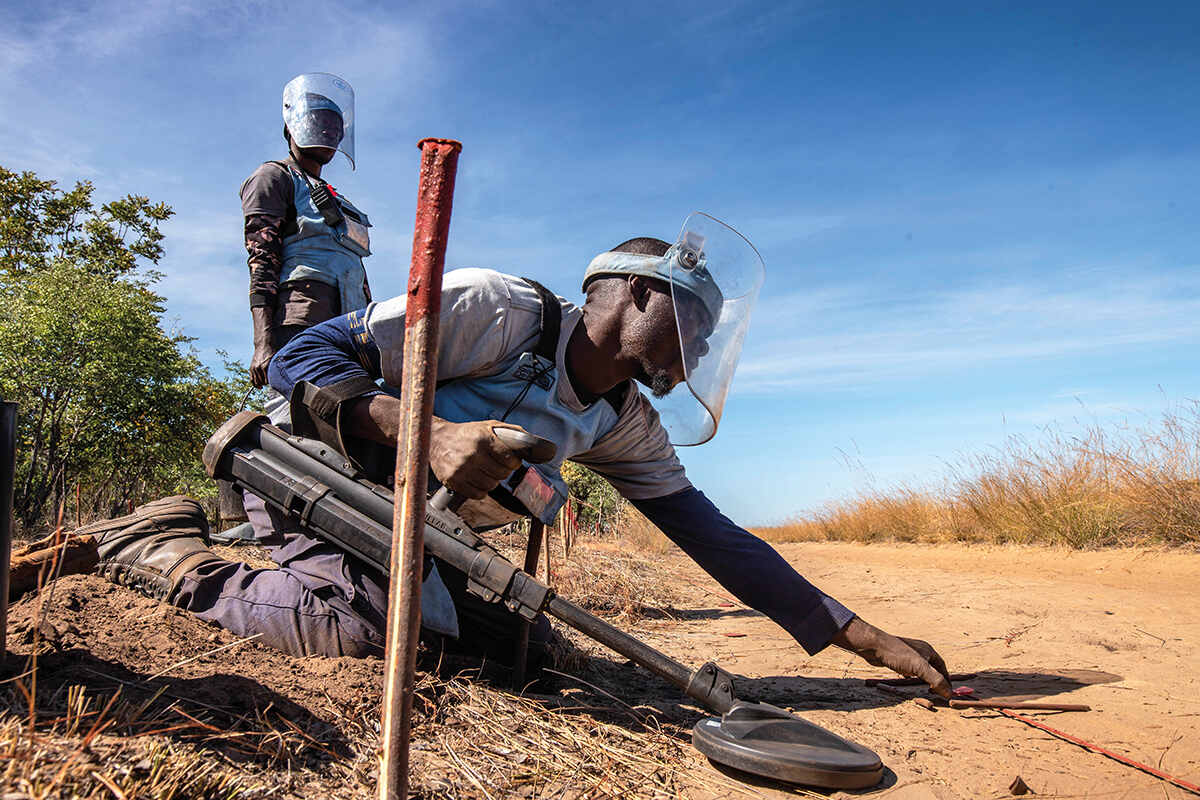
More than 1,000 minefields still need to be cleared in Angola. Tommy Trenchard joins the HALO Trust team undertaking the dangerous task of making what was once the home of some of the largest herds of elephants in Africa safe for locals, tourists and wildlife
Words and Images by
From the window of a single-engine Cessna at 6,000 feet, it’s easy to see why Angolans call this part of their country ‘the land at the end of the world’. Dense forests stretch as far as the eye can see, broken only by meandering crystalline rivers that steam gently in the cold dawn air. Below us lies the undulating expanse of Mavinga National Park, a remote wilderness of leafy miombo woodland that was once teeming with wildlife and home to some of Africa’s largest herds of elephants. From up here, it looks pristine and peaceful, but appearances can be deceptive.
In the pale, sandy soil, buried out of sight, lie tens of thousands of landmines left over from Angola’s decades-long civil war. Most of them have been there since the 1980s but they remain just as deadly today as they were on the day they were laid. With the landmine threat preventing effective conservation work, this former haven for wildlife has been reduced to a shadow of its former self. Loggers pillage the forests for timber and poachers target the few remaining large mammals. Conservationists and rangers are few, and tourists even fewer.
As the tiny plane bounces lightly on the thermals, its passengers scan the landscape below us intently. They work for the HALO Trust, the British de-mining charity that has been leading the fight against Angola’s landmines since the mid-1990s. In that time, the organisation has safely destroyed some 100,000 anti-tank and anti-personnel mines from all over the country. And yet, some 20 years after the end of the civil war, there are still thought to be at least 1,000 minefields still to be cleared.
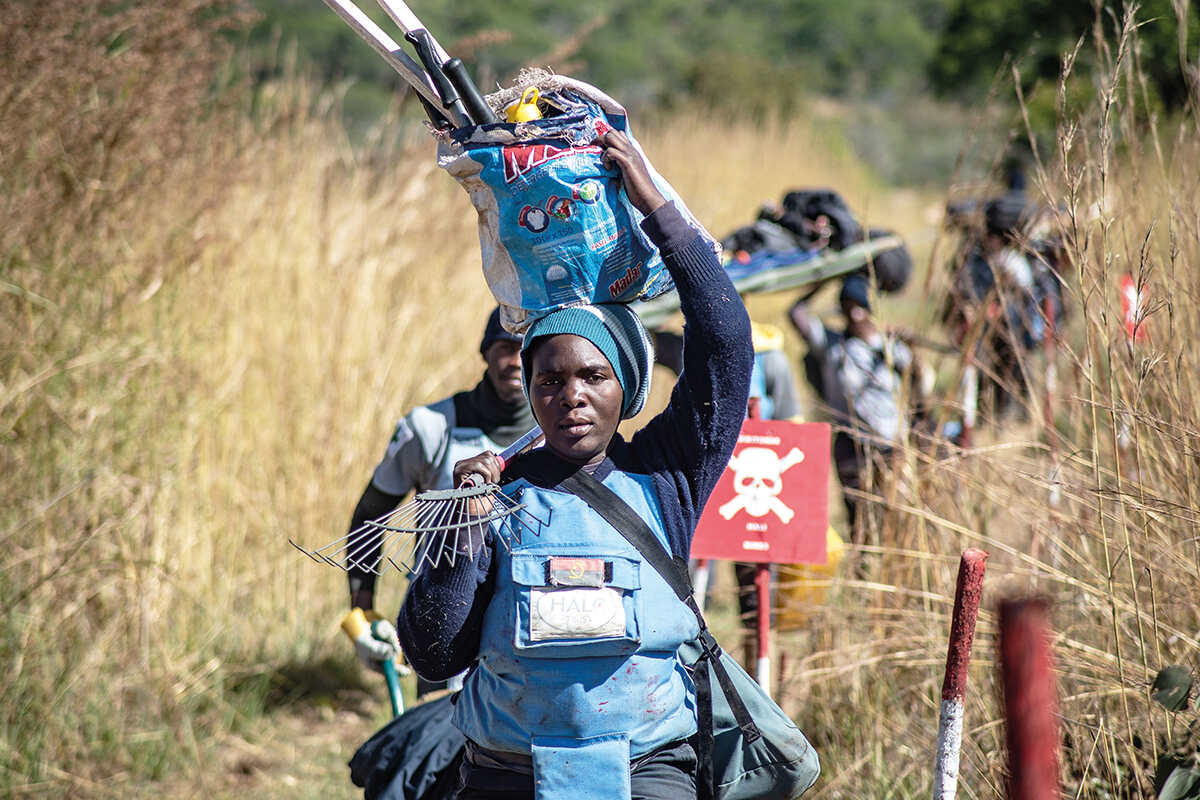
Until recently, most de-mining efforts have focused on urban areas, many of which have now been fully cleared of mines. But in the past two years, thanks to a US$60 million injection of funds by the Angolan government, attention has switched to this sparsely populated but ecologically critical part of the country. Clearing it will be no mean feat; the area’s two national parks, Mavinga and its neighbour, Luengue-Luiana, contain at least 150 known minefields.
‘The goal is very much to have two fully functioning national parks in the southeast, where human populations and wildlife can coexist,’ explains Rhys Mansel, HALO’s project manager for mine action and conservation. ‘Everyone really appreciates that the economy must diversify from oil and gas to something more sustainable like eco-tourism. But what tourist is going to want to come here, or what park ranger is going to want to patrol here, while the mines are still in existence?’
Throughout the flight, Mansel has been keeping up a running commentary over the roar of the engine, pointing out minefields known and suspected, rivers that were once battlegrounds, and, at one point, an illegal logging truck partially obscured by the trees. I keep my eyes peeled for signs of wildlife but see nothing – no tracks through the bush, no movement of any kind.
‘We’re pretty sure there’s a minefield around that lake,’ says Mansel, pointing out of the plane window towards a series of distant streaks in the otherwise uniform forest below. ‘There’s a lot of survey work still to do.’
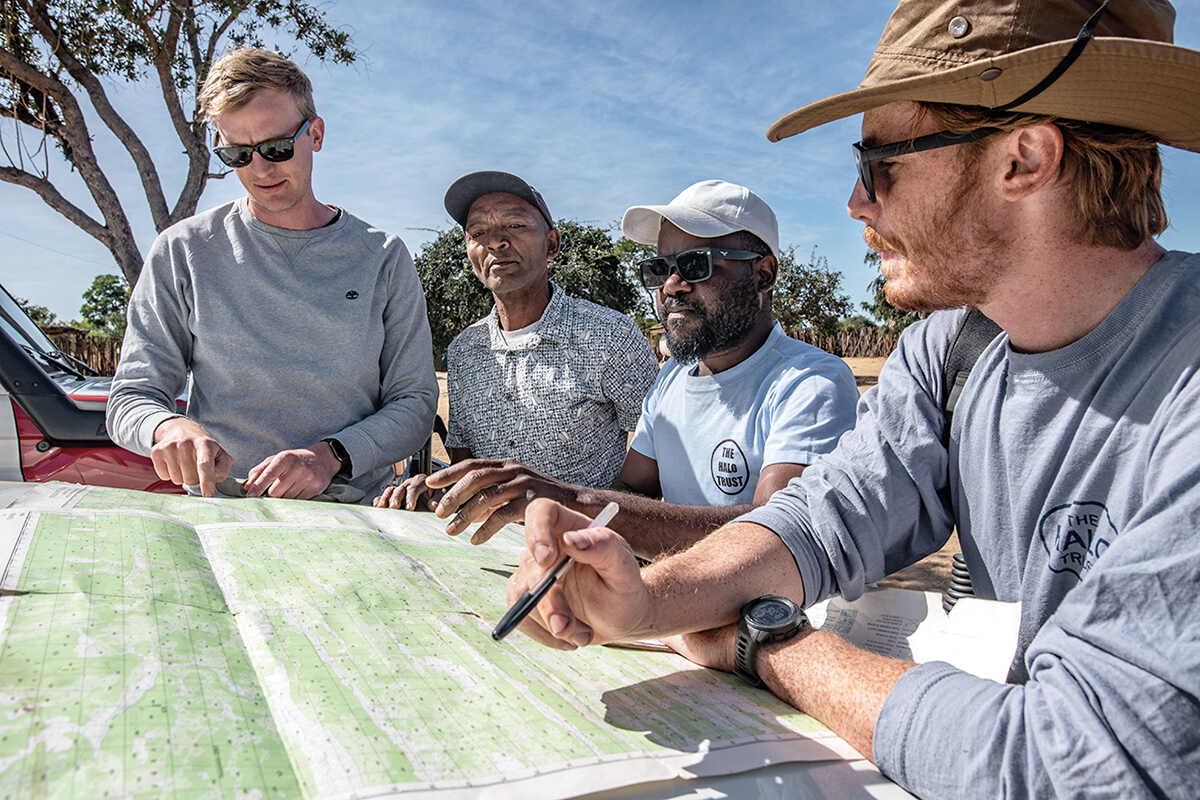
There were once as many as 100,000 elephants in Angola, many of them living here in the forests of Cuando Cubango province in the far southeast of the country. But since the outbreak of the conflict in 1975, their numbers have plummeted. Thousands were slaughtered by rebels, who funnelled the precious tusks out of the country to finance the war. Others fell victim to landmines and most of those that survived ended up fleeing across the border for the relative safety of Zambia, Botswana and Namibia.
Even after the war ended, the conservation vacuum allowed poaching to continue largely unchecked. According to the latest aerial survey, there are now fewer than 3,400 elephants left in the whole of Angola. Lions have fared even worse, with just ten individuals remaining in the two national parks.
Soon, the town of Mavinga looms into view and the pilot banks steeply over a sprawl of single-storey mud-brick homes before coming in to land on a broad dirt airstrip. Children cluster around to watch as the Cessna taxies towards a bevvy of waiting officials. We’re greeted by HALO’s field officer in Mavinga, Ronan Shenhav, who fills us in on recent developments during the short walk from the airstrip to the HALO camp, a large, sandy compound ringed with a wooden palisade and filled with white-tarpaulin tents.
‘We’re working on eight minefields in this area, but there are so many more,’ says Shenhav. ‘We’re finding new ones faster than we’re clearing them. The longer we stay, the more people come forward with information.’
In the past week alone, Shenhav explains, a young boy had turned up with a grenade he’d found just yards from the HALO base; another had discovered an unexploded 60-millimetre mortar shell just next to the town’s landing strip; and someone else had come to report that he’d identified an anti-tank mine while working in his fields. We dump our bags at the camp and grab a quick breakfast of scrambled eggs and lukewarm coffee before climbing into a Land Cruiser and setting off for the nearest minefields – an area of gently sloping land along the bank of a winding brook just outside the town.
At a makeshift shelter of sticks and thatch, the local supervisor gives us a short briefing on minefield safety and some background to the minefield, which he says was laid by UNITA rebels in 1989 to prevent their adversaries from getting to the brook in the valley below. Angola’s civil war was one of the great proxy conflicts of the Cold War, pitting UNITA, an anti-Communist guerrilla army supported by Western powers and the South African army against the Communist FAPLA, later the de-facto national army, which had the backing of the Soviet Union and fought alongside Cuban troops.
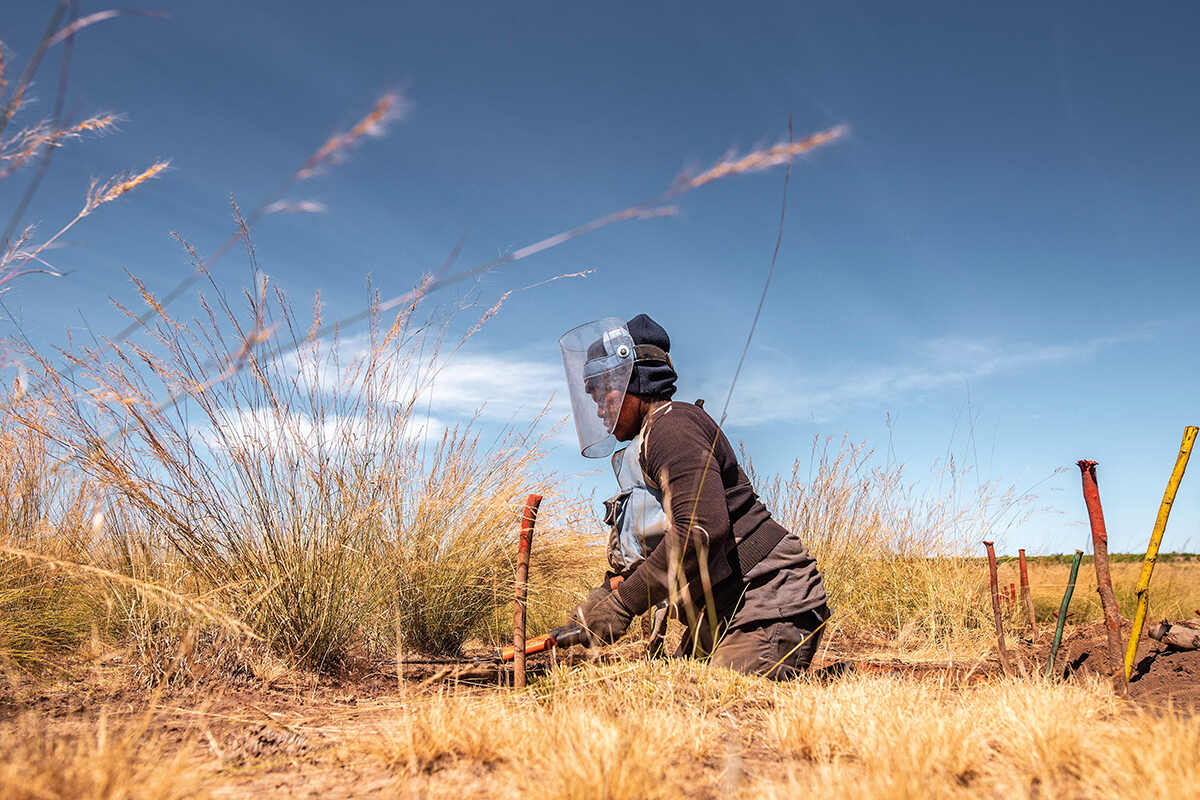
The supervisor takes note of our blood types, instructs us to put on our protective equipment, then leads us onto the minefield, where around a dozen men and women are inching slowly forward along the valley, swinging metal detectors smoothly back and forth in front of them. They wear light-blue body armour and their faces show expressions of intense concentration behind their thick protective visors.
De-mining is painstaking work. Using sticks and string, each de-miner measures out a block of one-by-two metres then scours the area thoroughly with a metal detector. If they find nothing, they step forward into the block and mark out the next one. When the detectors pick up a signal, the de-miners use specialised metal digging tools to carefully locate and uncover the source. Sometimes it turns out to be nothing more dangerous than a rusty nail or an old Coke can, but every so often it turns out to be a landmine with the capacity to instantly kill anything within a five-metre radius. These are then destroyed in a controlled blast.
‘The mines are a big problem here,’ says Rebecca Rosalina, a 42-year-old widow who signed up as a de-miner for HALO 12 months ago. So far, she has discovered three anti-tank mines, one anti-personnel mine and an unexploded mortar shell. ‘When the mines are gone, we’ll finally be able to move freely. Perhaps they’ll be able to build more schools, more hospitals, and there will be tourists coming here.’
Every minefield has its unique challenges and this one is no exception. First, the mines here were laid unusually deep, sometimes as much as 20 centimetres below ground. Second, the soil is heavily mineralised, confusing the highly sensitive metal detectors. As a result, huge volumes of soil have to be carefully scraped away before an area can be deemed safe. So far, the team on this minefield has cleared 3,134 square metres of land and destroyed 29 mines.
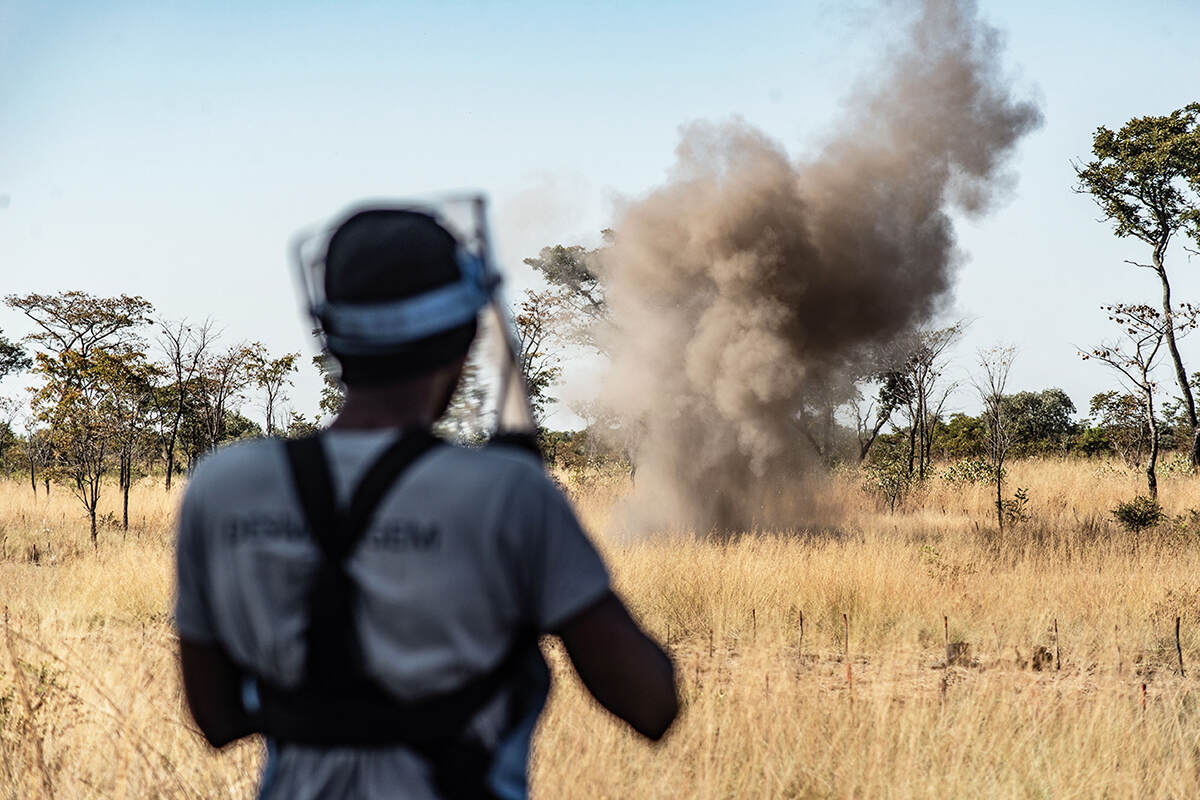
Due mostly to the intensive training they receive and adherence to a set of rigid safety protocols, accidents among HALO’s de-miners are remarkably rare, but it’s still nerve-racking work. One wrong move can trigger a mine and cause severe injury or death. As a precaution, work on this minefield stops at exactly ten past one in the afternoon so that, in the event of an emergency, a plane can be called in to evacuate the casualty and transport them to the nearest hospital before nightfall.
‘It’s not easy,’ says Rosalina. ‘But I wanted to help make Mavinga mine free. It feels good to be a part of this work’.
Like almost everyone in Mavinga, she has lost friends to landmines. In one case, three of her neighbours died in the same incident when their donkey cart struck an anti-tank mine on a path outside the town. According to the most recent census in 2015, there are thought to be as many as 88,000 Angolans living with injuries caused by landmines and other explosive remnants of the conflict, and accidents still happen all the time.
While making the land safe again for local residents is HALO’s first priority, recent years have seen the emergence of a new paradigm in de-mining, with partnerships forming between the de-mining and conservation sectors. Faced with shortages of funding from traditional humanitarian donors, an increasing amount of HALO’s work is now paid for by donors that focus on the environment and conservation. This is especially the case here in Angola, where interest from conservationists has been growing due, in large part, to the fact that the country contains much of the watershed of the great Okavango Delta, which provides drinking water to a million people in southern Africa and supports some of the planet’s largest concentrations of wildlife.
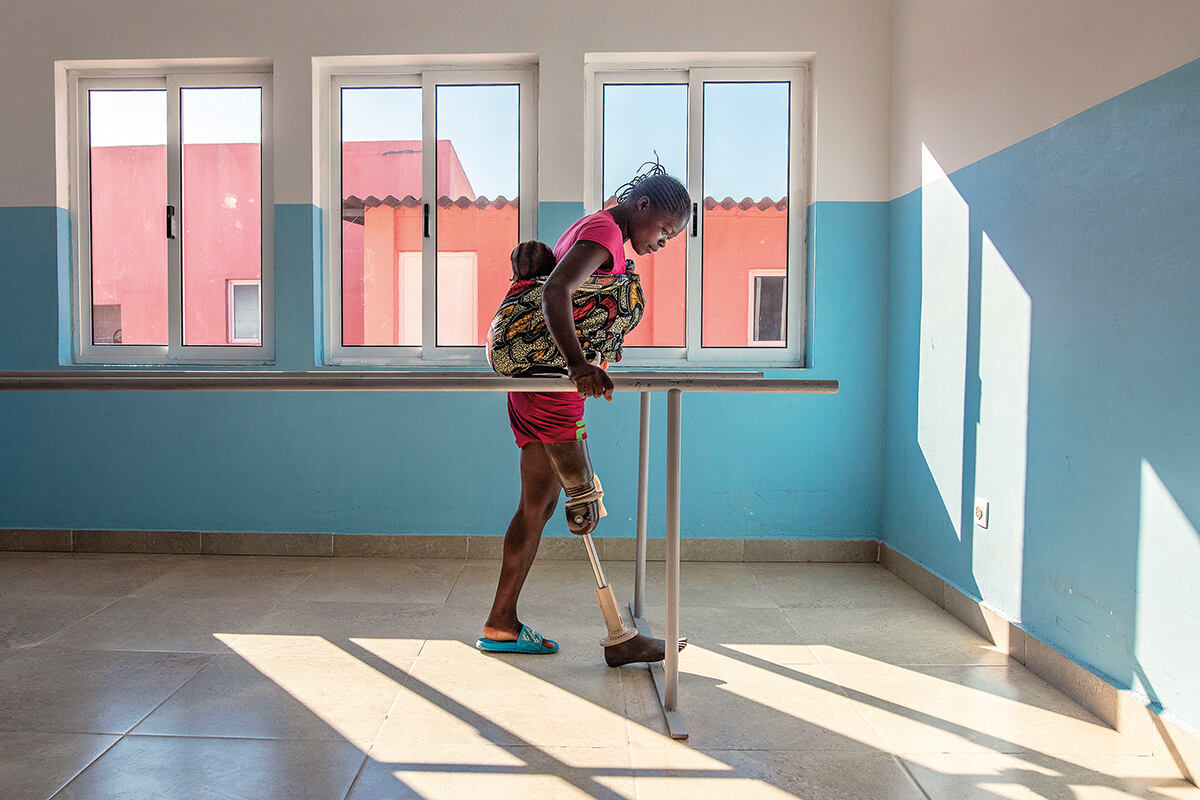
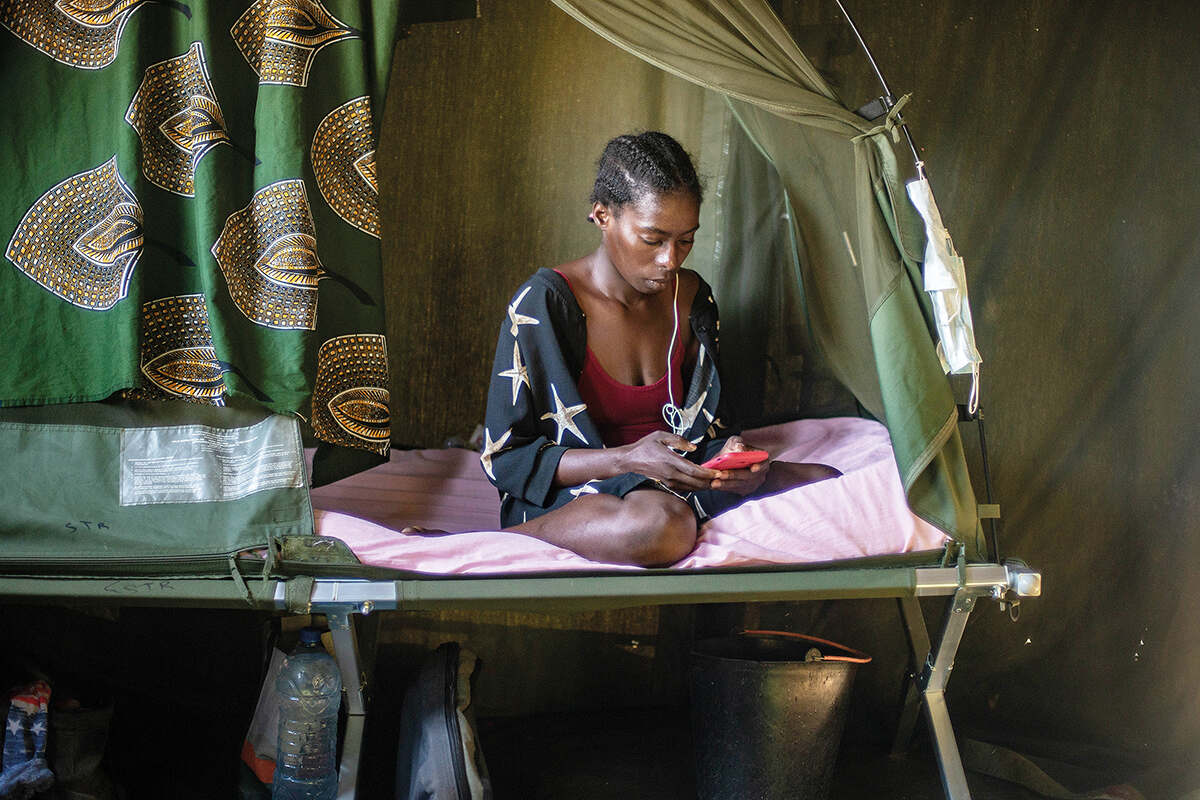
In 2018, the US Congress passed the Delta Act, a bill designed to support Angola and its neighbours in protecting the critically important Kavango-Zambezi Transfrontier Conservation Area. And in 2019, the Angolan government signed a memorandum of understanding with the African Parks Network, the first step in a potential takeover of the management of Mavinga and Luengue-Luiana national parks. Meanwhile, plans have been mooted to open up migration corridors to allow refugee elephant populations to return to Angola from neighbouring countries, or even to translocate elephants directly from Botswana once the mine threat has been removed.
And since 2015, the National Geographic Okavango Wilderness Project (OWP), a partnership between the National Geographic Society and the Wild Bird Trust, has been sending teams of scientists to explore the rivers that make up the Okavango basin, some of which have never before been properly studied. Locals call the area, Lisima lay Mwono, or ‘the source of life’.
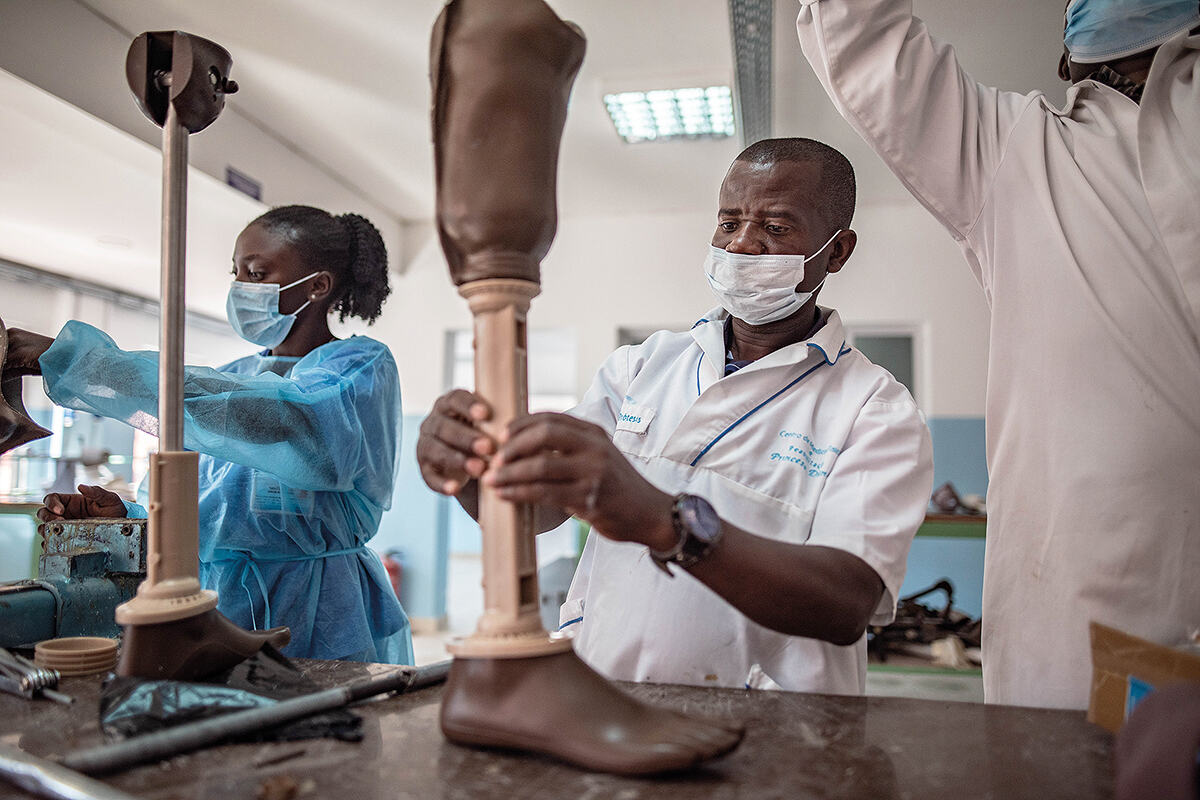
‘The Lisima area was a kind of black hole for biodiversity information,’ said the OWP’s regional director, John Hilton. ‘And what we’ve now discovered is this new centre for biodiversity endemism.’
With logistical support from HALO, the project has so far discovered more than 50 previously undescribed species and identified some of the most significant carbon-storing peat deposits in Africa, building a scientific dataset that Hilton and his team hope will aid regional governments in their efforts to protect the area.
The project’s discoveries have shown that, while war and landmines have been detrimental to the region’s larger, more charismatic fauna, they may conversely have had a positive impact on its rivers and the many smaller, less commercially valuable species by protecting the area from the general threats associated with human encroachment, such as expanding agriculture and deforestation. As a result, the removal of the mines may pose risks as well as opportunities.
‘The landmines have protected the place from development, for sure,’ said Hilton. ‘They slowed the return of people to the landscape. Now that more roads and areas are safe, people have been slowly trickling back in and living their traditional life, which involves taking down trees for honey production and for charcoal, which is the only source of fuel for many of these communities’.
The project is working with local communities to support sustainable livelihoods and alternative fuel sources in order to prevent environmental damage as people begin to return to their villages. For now, however, returnees remain comparatively few. And with information on new minefields still flowing in, HALO and its partners believe that large-scale returns of either people or wildlife remain some way off.

The morning after our visit to the minefield, a wiry man in a short-sleeved paisley shirt and FILA baseball cap enters the HALO compound in Mavinga and introduces himself to Shenhav. His name is Avelino Sampaio. He’s 61 years old and he says he was a guerrilla fighter with UNITA during the war and took part in laying many of the area’s minefields. He unfurls a faded military map with ‘Top Secret’ printed in block capitals across the top and lays it out on the bonnet of a HALO Land Cruiser.
‘Our enemies were using explosives so we had to do the same,’ says Sampaio. ‘In war, you’ll use any tool that you can in order to defend yourself. Tomorrow was not seen as important’.
Using a short stick, Sampaio starts pointing out locations on the map where he knows there are mines. For the most part, he says, they focused on water sources, trying to prevent the government forces from moving south through this part of Cuando Cubango during the late 1980s. In this arid terrain, access to water was critical for both armies.
‘There’s a minefield right here,’ he says, indicating a point on the map near the confluence of the Lomba and Cunzumbia rivers. ‘And another one here by this lake. And here at Lake Dinde – accidents still happen there all the time.’
As the HALO team takes notes, Sampaio picks up a stick and starts marking out a pattern in the sand to indicate how the mines were laid. ‘Here they’re very dense, like this,’ he says. ‘They’re one metre apart.’
Since the end of the war, Sampaio tells us, he has been working with the Angolan government’s de-mining programme, but he says a severe lack of resources has hamstrung the work. ‘We struggle with logistics, medication, transport and funding,’ he explains. ‘But we cleared some roads and landing strips.’
Over the next few days, as we explore the area, the impact of the mines on the area’s wildlife becomes increasingly apparent. In Nancova, a tiny village on the banks of the breathtakingly beautiful Cuito River, some of the older locals can still remember a time when elephants and lions were regular visitors. Now, they are entirely absent. Aside from their toll on human lives, the mines around Nancova have restricted agriculture and cut the town off from regional markets, leaving few viable livelihoods for residents. Today, poaching for bushmeat is one of the few opportunities available.
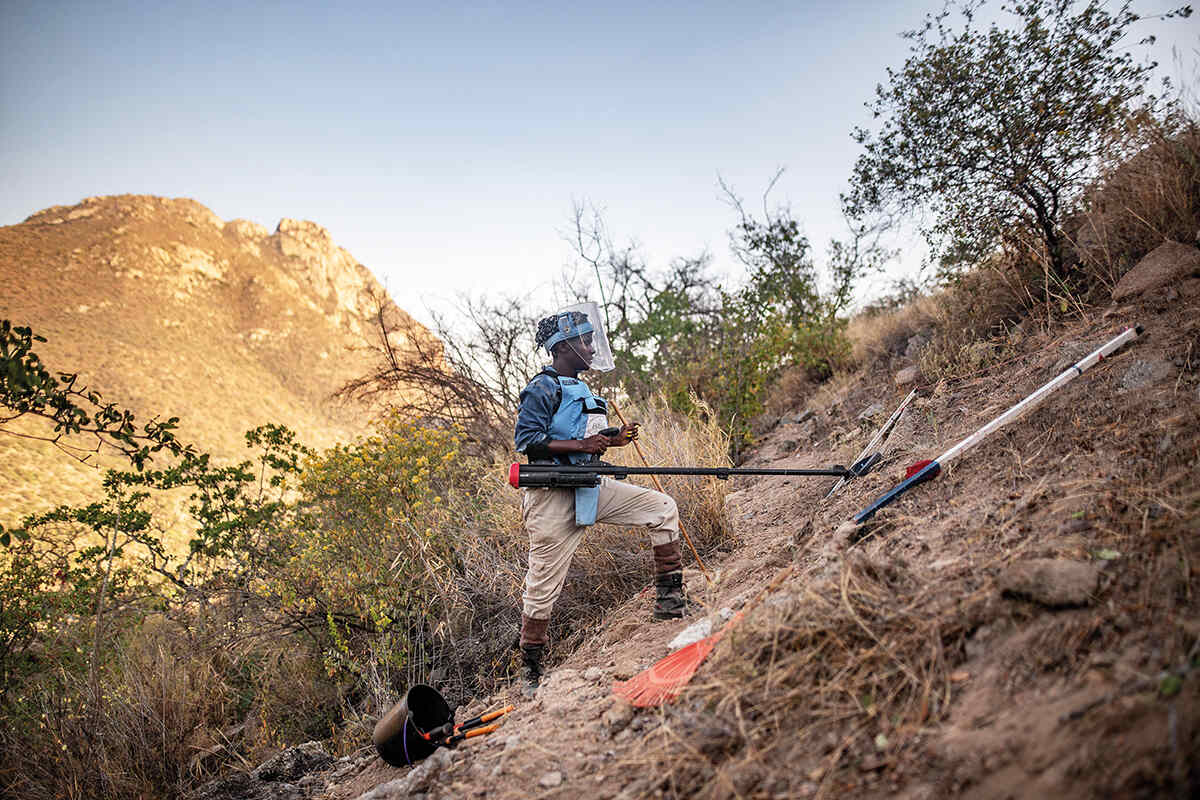
In Cuito Cuanavale, a town that saw some of the fiercest fighting of the civil war, where there’s estimated to be roughly one mine for each of the 40,000 inhabitants, the skull of an elephant killed by an anti-tank mine now lies like a macabre museum exhibit in the corridor of HALO’s regional office. To the east, on the banks of the Lomba River, which is lined with at least 27 different minefields, elephants are still occasionally seen, but the bones of wildlife killed by mines litter the local woodlands.
After visiting the local HALO de-miners at work on one of the Lomba’s many minefields, Mansel stands at the edge of the treeline looking out over the river valley, where chest-high savannah grasses sway this way and that in the late-morning breeze. ‘Can’t you just imagine this teeming with wildlife?’ he says, gesturing at the scene before us. ‘And before the war, it really was.’
A short while later, a huge boom erupts from the nearby forest. The de-miners have destroyed a South African-made anti-tank mine in a controlled detonation that sends a column of grey smoke billowing 60 metres into the sky. It’s a reminder of the extraordinary destructive power of these indiscriminate weapons. But it’s also a marker of progress in the Herculean struggle to make Angola safe again, a struggle the de-miners are slowly but surely winning.




